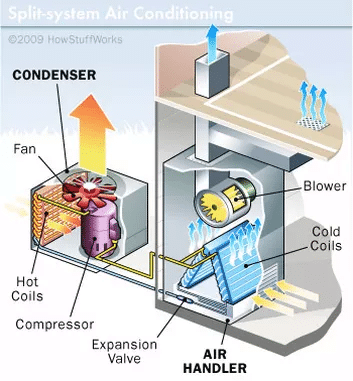Like driving a car, most people can enjoy their home AC without knowing all the details of how it works; however, the concepts are easy to understand and actually quite interesting. Let’s look at an AC functional diagram.
The basics of cooling your home is about removing heat from the refrigerant. This is done by turning the refrigerant by compressing and decompressing the refrigerant to transform it from a liquid to a gas and back to a liquid. As the refrigerant is compressed, it becomes hot. When it is decompressed, it becomes cold.
There are 2 units used in the typical residential AC system
Outdoor Unit: is often called the Condenser Unit. It is a rectangular box sitting out of the house. Key components located in the outdoor unit is the compressor, the condensing coils, and a large fan.
Indoor Unit: is typically attached to the furnace system. They share a common blower fan to blow conditioned air into the house through the ducts and vents. Key components located in the indoor AC unit are the evaporative expansion valve, the evaporator coils, and the blower fan.
The refrigerant is a chemical that travels through the lines in a circular path between the outdoor unit and the indoor unit. As the refrigerant travels, it will be compressed, which causes the refrigerant to get hot, and decompressed, which causes the refrigerant to get cold.
Beginning with the outdoor unit, let’s look at the refrigerant loop and how it works.
Outdoor Unit: the refrigerant enters the compressor has a low pressure gas. The compressor pressurizes the refrigerant to a high temperature gas. The compressor contains a lubricant oil which does not work well when the outdoor temperature is under 60 degrees and can actually damage the compressor. For that reason, home inspectors should not operate the AC system when the outside temperature is below 60 degrees.
The compressor compresses and heats the refrigerant gas and sends it to the condensing coils which lines the outside walls of the outdoor unit. The fan in the unit draws outside air in through the condensing coils and out through the fan. The outside air is used to help cool the refrigerant. The condensing coils cools the refrigerant to a lower pressure and temperature and sends it to the indoor unit as a liquid.
Indoor Unit: the refrigerant passes through an expansion valve which allows the refrigerant to decompress and turns from liquid back to a cold, low pressure gas. The temperature of refrigerant is now about 25 to 30 degrees. The refrigerant then passes through the evaporator coils. Warm house air coming from the return vents is blown over these coils and the heat is actually removed from the air before it enters the house as cold air.
Clean air filters are an essential part of the AC system. Dirty air filters can block the amount of air blowing through the evaporator coils thus making the AC system work harder and is more inefficient.
As the refrigerant passes through the evaporator coils, the refrigerant warms up, becomes a low pressure liquid, and is passed back to the outside unit to the compressor. The cycle repeats itself, thus cooling the house.
How can you tell if your system is working properly?
One of the tests is to measure the temperature of the air at the return vent and the temperature of the air at the register where cold air is entering the house. This is actually measuring the effectiveness of the AC before and after the house air passes through the evaporator coils. The difference in temperature should be about 14 to 24 degrees. A difference that is less or more than this range is an indicator that the unit is not operating properly. A HVAC technician should be called to conduct further tests.
So your home AC works simply by applying simple laws of physics. When you compress a gas it gets hot. When you decompress a gas, it becomes cold. The AC goes just a little bit further than that by transforming the gas to a liquid and back to a gas.



